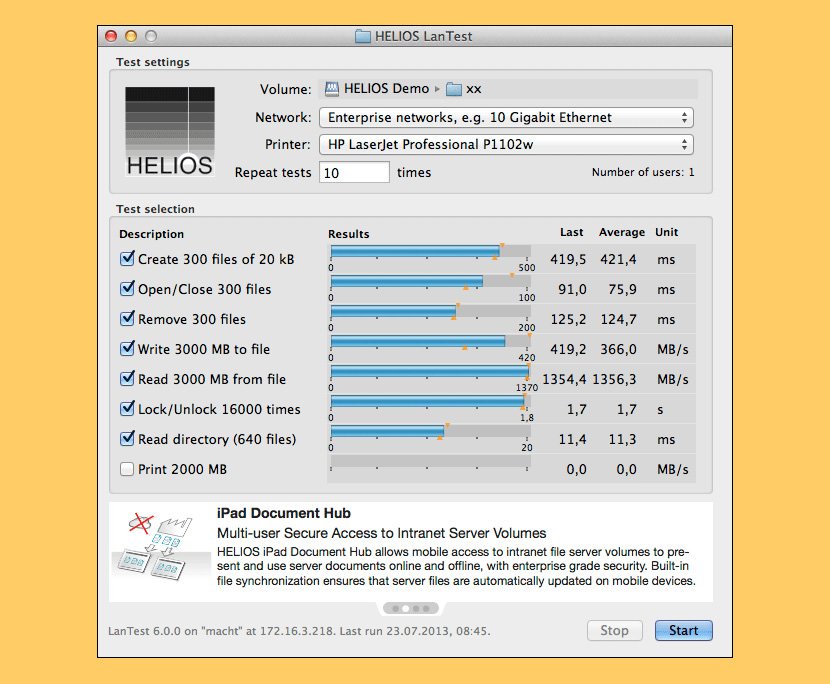Network Card Performance Test
Network performance from an end-user perspective. The R&S network performance test (R&S®DATA-NPT) overcomes the disadvantages of traditional capacity testing: instead of completely downloading fixed files or specifically tailored packet blocks, it uses plain file uploads and downloads for a defined period of time (a few seconds). Test Hardware provides enterprise-wide application and security testing from anywhere, anytime. Enable browser cookies for improved site capabilities and performance. Enable Javascript and browser cookies for improved site capabilities and performance. A few years ago, frametime testing was introduced to the tech media which allowed us to analyze far more than the average FPS performance in games. While FPS results showed us a basic idea of how graphics card perform in each game, it does not show the full picture of what the experience we liked.
- Whether the network interface card (NIC) is part of your PC’s motherboard circuitry or attached as an expansion card, you can inspect its status by using the Device Manager in Windows 7 and Windows Vista. Follow these steps to check on the NIC hardware: Open the Control Panel. Open the Device Manager. In Windows 7,.
- Network benchmark - test your network speed. Almost all computers these days have a network connection of some description. Whether it be a modem connection to an ISP, or an Ethernet connection to a corporate intranet, sending and receiving data to and from other computers is an essential part of day to day operations.
Introduction
The Relationship of Bandwidth and Packet Forwarding Rate
Other Performance Metric Relationships
Conclusions
Acknowledgments
References
Building and operating an IP network requires an in-depth understanding of both the infrastructure and the performance of devices that are used within the network, including how packets are handled by each network device. Network engineers most often refer to the performance of network devices by using the speed of the interfaces expressed in bits per second (b/s). For example, a network device may be described as having a performance of 10 gigabits per second (Gb/s). Although this is useful and important information, expressing performance in terms of b/s alone does not adequately cover other important network device performance metrics.
Depending on the type of network device, additional performance metrics might be required to fully describe how the device will perform. This is particularly important when high-touch features are configured and the device is under a high network load. Metrics that are expressed in terms such as packets per second (p/s), connections per second (c/s), transactions per second (t/s), and maximum concurrent connections (mcc) also provide information that can be vital to a more complete understanding of the device performance characteristics.
For example, routers and switches are generally considered to be stateless devices because they forward each packet independently. Thus, metrics such as b/s and p/s may be sufficient to describe the performance of these devices. However, devices like firewalls, intrusion prevention systems, and load balancers, which create and maintain state tables to forward packets, require additional metrics, such as c/s and mcc, to fully and accurately describe their performance. Mathematical relationships can be defined, either directly or indirectly, between bandwidth and these additional metrics. The remainder of this document discusses these relationships, in addition to describing the metrics themselves and their importance to understanding network device performance.
Note: Additional metrics beyond those described in this document may be highly relevant for specific devices under specific operating conditions. Knowing interface, queue, and processing delays; delay variability; latency; and other forwarding-related metrics can be critical, especially in delay-sensitive voice and video traffic environments. System performance may vary depending on configured features, traffic type (for example, unicast versus multicast), and load. When designing networks, administrators should consider all factors that are pertinent to their specific environments.

Network devices receive and forward packets through physical interfaces that employ Layer 2 technologies, such as Ethernet and Packet Over SONET (POS) framing. The description for these network links always includes bandwidth that is expressed in terms of b/s. By performing simple mathematical manipulations, it is possible to determine the potential range of p/s, or more correctly, frames per second (f/s) that a network link can support.
For example, the very common 1-Gb/s Ethernet interface is capable of transmitting up to 1,000,000,000 b/s. To determine p/s, first convert bits to bytes. (There are eight bits in one byte.) Then consider how many bytes exist in each packet. The size of the packet does not have to be a fixed value, but administrators can bound the problem by recognizing that there are both minimum and maximum packet sizes. The minimum size is based on both the IP-defined minimum IP packet size and the Layer 2-defined minimum frame size. The maximum IP packet size is based on the link maximum transmission unit (MTU) for the Layer 2 technology. Based on these factors, and using Ethernet as an example, the following two calculations can be considered:
Network Card Performance Test Sample
- Maximum Frame Rate (Minimum Frame Size)
- Maximum Throughput (Maximum Frame Size)
The maximum Ethernet frame rate is achieved by a single transmitting node that does not suffer any collisions when Ethernet frames are at their smallest size. The minimum Ethernet frame payload is 46 bytes (based on the slot time of Ethernet), which yields a frame that consists of 72 bytes (see Table 1) plus a 12-byte inter-frame gap, for a total Minimum Frame size of 84 bytes.
The maximum Ethernet throughput is achieved by a single transmitting node that does not suffer any collisions when the Ethernet frames are at their maximum size. The maximum Ethernet frame payload is 1500 bytes (not considering Jumbo frames), which yields a frame that consists of 1526 bytes (see Table 1) plus a 12-byte inter-frame gap, for a total Maximum Frame size of 1538 bytes. (This calculation provides the lower bound on frame rate.)
Test Network Card For Problems
Table 1. Maximum Frame Rate and Throughput Calculations For a 1-Gb/s Ethernet Link